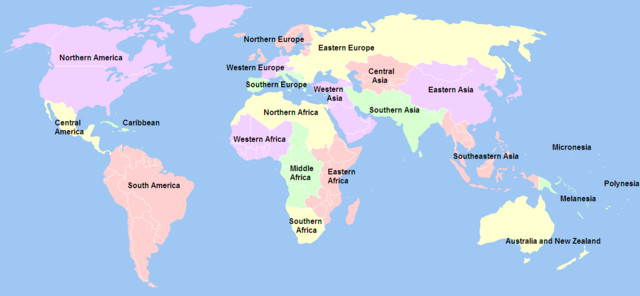Top Qs
Timeline
Chat
Perspective
United Nations geoscheme
UN system for grouping the world's 248 countries and territories into regions and subregions From Wikipedia, the free encyclopedia
Remove ads
The United Nations geoscheme is a system that divides 248 countries and territories in the world into six continental regions, 22 geographical subregions, and two intermediary regions.[1] It was devised by the United Nations Statistics Division (UNSD) based on the M49 coding classification.[2] The creators note that "the assignment of countries or areas to specific groupings is for statistical convenience and does not imply any assumption regarding political or other affiliation of countries or territories".[2]

The UNSD geoscheme was created for statistical analysis and consists of macro-geographical regions arranged to the extent possible according to continents.[2] Within each region, smaller geographical subregions and sometimes intermediary regions contain countries and territories. Countries and territories are also grouped non-geographically into selected economic and other sets, such as the landlocked developing countries, the least developed countries, and the Small Island Developing States.
Antarctica does not comprise any geographical subregions or country-level areas.
The UNSD geoscheme does not set a standard for the entire United Nations System, and it often differs from geographical definitions used by the autonomous United Nations specialized agencies for their own organizational convenience. For instance, the UNSD includes Cyprus and Georgia in Western Asia, yet the United Nations Industrial Development Organization and UNESCO include them in Europe.[3][4] This statistical definition also differs from United Nations Regional Groups.
Alternative groupings include the World Bank regional classification,[5] CIA World Factbook regions and Internet Corporation for Assigned Names and Numbers Geographic Regions.[6][7][8]
Remove ads
Maps
Remove ads
Africa
Northern Africa
Sub-Saharan Africa
Eastern Africa
Middle Africa
Southern Africa
Western Africa
Remove ads
Americas
Latin America and the Caribbean
Caribbean
 Anguilla[a]
Anguilla[a] Antigua and Barbuda
Antigua and Barbuda Aruba[b]
Aruba[b] Bahamas
Bahamas Barbados
Barbados- Bonaire, Sint Eustatius and Saba[c]
 British Virgin Islands[a]
British Virgin Islands[a] Cayman Islands[a]
Cayman Islands[a] Cuba
Cuba Curaçao[b]
Curaçao[b] Dominica
Dominica Dominican Republic
Dominican Republic Grenada
Grenada Guadeloupe[d]
Guadeloupe[d] Haiti
Haiti Jamaica
Jamaica Martinique[d]
Martinique[d] Montserrat[a]
Montserrat[a] Puerto Rico[e]
Puerto Rico[e] Saint Barthélemy[f]
Saint Barthélemy[f] Saint Kitts and Nevis
Saint Kitts and Nevis Saint Lucia
Saint Lucia Saint Martin (French part)[f]
Saint Martin (French part)[f] Saint Vincent and the Grenadines
Saint Vincent and the Grenadines Sint Maarten (Dutch part)[b]
Sint Maarten (Dutch part)[b] Trinidad and Tobago
Trinidad and Tobago Turks and Caicos Islands[a]
Turks and Caicos Islands[a] United States Virgin Islands[g]
United States Virgin Islands[g]
Central America
South America
 Argentina
Argentina Bolivia (Plurinational State of)
Bolivia (Plurinational State of) Bouvet Island[h]
Bouvet Island[h] Brazil
Brazil Chile
Chile Colombia
Colombia Ecuador
Ecuador Falkland Islands[a]
Falkland Islands[a] French Guiana[d]
French Guiana[d] Guyana
Guyana Paraguay
Paraguay Peru
Peru South Georgia and the South Sandwich Islands[a]
South Georgia and the South Sandwich Islands[a] Suriname
Suriname Uruguay
Uruguay Venezuela (Bolivarian Republic of)
Venezuela (Bolivarian Republic of)
Northern America
Asia
Summarize
Perspective
Central Asia
Eastern Asia
Note on Taiwan
Several institutions and research papers using classification schemes based on the UN geoscheme include Taiwan separately in their divisions of Eastern Asia.
- The Unicode CLDR's "Territory Containment (UN M.49)" includes Taiwan in its presentation of the UN M.49.[9]
- The public domain map data set Natural Earth has metadata in the fields named "region_un" and "subregion" for Taiwan.
- The regional split recommended by Lloyd's of London for Eastern Asia (UN statistical divisions of Eastern Asia) contains Taiwan.[10]
- Based on the United Nations statistical divisions, the APRICOT (conference) includes Taiwan in East Asia.[11]
- Studying Website Usability in Asia, Ather Nawaz and Torkil Clemmensen select Asian countries on the basis of United Nations statistical divisions, and Taiwan is also included.[12]
- Taiwan is also included in the UN Geoscheme of Eastern Asia in one systematic review on attention deficit hyperactivity disorder.[13]
Note on Northern Asia
This unofficial subregion covers the entire geographical region of Siberia. Since this region as a whole falls under the transcontinental country of Russia, for statistical convenience, Russia is assigned under Eastern Europe by the UNSD, including both European Russia and Asian Russia under a single subregion. Hence, there is no geopolitical entity that is currently grouped under Northern Asia.
South-eastern Asia
This subregion covers the geographical regions of Mainland Southeast Asia and Maritime Southeast Asia, covering the following geopolitical entities as a whole:
Southern Asia
This subregion covers the geographical regions spanning over the Indian subcontinent and the Iranian Plateau, covering the following geopolitical entities as a whole:
Western Asia
This subregion covers the geographical regions spanning over Anatolia, Arabia, the Levant, Mesopotamia, and the South Caucasus, covering the following geopolitical entities as a whole:
Remove ads
Europe
Summarize
Perspective
Eastern Europe
† Although Russia is a transcontinental country covering Northern Asia as well, for statistical convenience, Russia is assigned under Eastern Europe by the UNSD, including both European Russia and Asian Russia under a single subregion.
Northern Europe
Southern Europe
Western Europe
Remove ads
Oceania
Australia and New Zealand
Melanesia
Micronesia
Polynesia
Remove ads
See also
Notes
- Part of the Dutch Caribbean and a constituent country within the Kingdom of the Netherlands
- A part of the Dutch Caribbean and a public body within the Kingdom of the Netherlands.
- An overseas department and region of France.
- A commonwealth and unincorporated territory of the United States.
- An overseas collectivity of France.
- An unincorporated and organized territory of the United States
- A dependency of Norway
- A constituent country within the Danish Realm
Remove ads
References
Wikiwand - on
Seamless Wikipedia browsing. On steroids.
Remove ads





